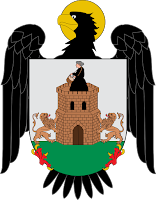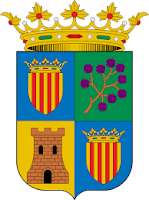CANTAVIEJA

If there is any one town in the Maestrazgo that could be termed the historical heart of the region, that town just has to be Cantavieja.
Not surprisingly, it is one of the only three places in the Maestrazgo with a population exceeding 500 inhabitants, having lost nearly four times that amount in the last 100 years.
It was some years ago that I had the idea of visiting this extraordinary town that had a strong connection with one of my local golf clubs back in England.
 |
| Wentworth golf club |
 |
| Wentworth golf club |
Legend has it that the Cantavieja castle was actually built by Hannibal when he invaded Spain from Carthage on his way to Rome, at the same time hounding the complacent Roman army. Although I find it a little difficult to believe that Hannibal had time to stop and build castles at such a distance from the main coast road along which he was travelling.
Parking in the main square of Cantavieja we found the Casa Sara not far from the tourist office and the Town Hall.
 |
| Town Hall |
 |
| The artisan bakery |
In this casa rural we were confronted by a rather steep staircase. However once at the top we found ourselves in what was, at that time, the dining room. There to meet us was the owner the delightful Raquel.
 |
| House of flowers |
 |
| The council chamber |
No visit to Cantavieja would be complete without a visit to the prestigious four star Hotel Spa Balfagon.
Just passing through the entrance doors I feel the warmth of this special place enfold me. Everything there is first class and with the help of Sara, who is in charge, or Mari and Sonia on the reception all is well.
It is not important if you drop in there just for a drink, a meal or just information on Cantavieja and the area you will receive the very best attention. The reception will help you with your plans for discovering the Maestrazgo either walking or mountain bike riding. In fact all that you would wish for a break.
General Ramón Cabrera y Griño
It did not take long to realize that the town has a definite historical advantage over the rest of the region’s centres. That of a ready made hero, General Ramón Cabrera y Griño
El Cid might well have been wandering around the area some several hundred years before, promoting his ready made mercenaries to the highest bidder, or Hannibal with his elephants and army tramping through, but Cantavieja can lay claim to being the authentic stronghold of a more recent, in fact, less than two hundred years past, leader of the Carlista rebel movement.
And what a character was Ramón!
Born in Tortosa in 1806, a thriving fishing village crouched on the banks of the Ebro River, a little before it spills into the Mediterranean sea, Ramón was the son of a reasonably well off family. His father, a successful merchant mariner who owned a 25 ton sloop, unfortunately died when the boy was only five years old and his mother, Maria Griño, pressed him into religious studies. Eventually Ramón was admitted into the seminary at Tortosa where it soon became obvious by his unruly behaviour that he was certainly not going to be capable of acting as a spiritual guide to anyone. It was Bishop Victor Saez that suggested he would possibly be more suited to a military career. So taking the Bishop’s advice Ramón joined the military on the side of the Carlistas in favour of the pretender to the throne, Don Carlos brother to Fernando VII. This had come about due to the death of Fernando IV in 1833 when Maria Cristina had become Queen Regent on behalf of the Infant daughter of Isabel II. Because of his ability and daring, Ramón Cabrera rapidly rose through the ranks and eventually made it to general. However it was then that he began to attract adverse publicity for his attitude towards the lives and property of non-combatants and the shooting of prisoners and local town mayors which followed his mother being arrested and executed by government forces.
He then gained the title of being the 'Tiger of the Maestrazgo'.
The Carlista war lasted over a period of four decades and finally Cabrera was forced to flee across the Pyrenees to France, with around eight thousand of his troops and their families. There the French confined him to a fortress before eventually releasing him. It was then Ramón made the decision to go to England as the British were sympathetic to the Carlista cause and where he would be made welcome.
What is also interesting is that his troops, finding themselves unemployed, apparently there was a lack of wars in Europe at that particular time, headed off in the other direction, to America and that country’s own particular Civil War. Enlisting in the various confederate armies including the ‘Louisiana Tigers’ and the ‘Tennessee Second Division’, they must have felt somewhat at home fighting with much ferocity and excelling themselves to the extent that the survivors were automatically awarded North American Citizenship by the orders of Jefferson Davis who was the problematic statesman in charge of the Confederate armies. It was after a particular gruelling battle of Malvern Hill in Virginia they were allowed to fight under their own officers and the Carlista flag, fighting side by side with the Republicans and wearing their red berets. Confederate General Ambrose P. Hill, recognising their ability was quoted as saying, “My rough, tattered and brave lions of providence.”
As for Ramón Cabrera, officially ‘Conde de Morella’ now in England, he was fortunate enough to marry Marianne Catherine Richards daughter of Robert Richards QC. This wealthy family of merchants and lawyers were sympathisers with the Carlista cause and befitting such a family the General and his wife settled into their home in Wentworth, Virginia Water, just twenty miles from London. The year 1850. This particular property having belonged to the Duke of Wellington’s brother in law, Sir Edward ‘Ned’ Pakenham and is today, believe it or not, the prestigious Wentworth Golf Club. Imagine that! After forty years in the most bleak mountainous region of Spain, as a rebel leader, to the comparative comforts of being a gentleman farmer in sophisticated Surrey, England. They had four children of which one, Ramón Cabrera Richards became the bodyguard and Master of Ceremonies to Kaiser Wilhelm of Germany. The old General Ramón Cabrera died in 1887 after which his wife continued to support the Carlista cause by generous donations of money.
Today there is the Carlista museum in Cantavieja in the same building as the local tourist office which consists of three floors of graphic illustrations combined with an audio video depicting the Carlista wars. Also just hidden away from the main square is a wonderful artisan bakery. This is well worth a visit. I buy my bread there and even after two days at home it is just as fresh.







Comments
Post a Comment